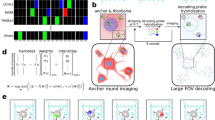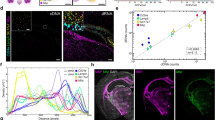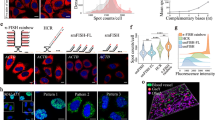Abstract
Noncoding RNAs (ncRNAs) comprise a diverse group of RNAs that function in essential cellular processes such as pre-mRNA splicing and mRNA translation and also regulate various aspects of gene expression in physiology and development. Methods of subcellular and tissue localization of ncRNAs are essential to understand their biological roles and their contribution to disease. We describe a rapid fluorescent (FISH) or chromogenic (CISH) in situ hybridization protocol for localization of ncRNAs (including microRNAs (miRNAs), small nucleolar RNAs (snoRNAs), small nuclear RNAs (snRNAs), piwi-associated RNAs (piRNAs) and ribosomal RNAs (rRNAs)) in formalin-fixed, paraffin-embedded (FFPE) tissues and cultured cells, using locked nucleic acid (LNA)-modified oligonucleotides. In this protocol, sections are heated in citrate buffer, which eliminates the need for protease treatment, thus preserving optimal morphology and protein epitopes, and allowing the simultaneous detection of proteins with immunofluorescence staining (IF). LNA–FISH requires 5 h, or between 10 and 36 h when combined with IF; LNA–CISH requires 2 d.
This is a preview of subscription content, access via your institution
Access options
Subscribe to this journal
Receive 12 print issues and online access
$259.00 per year
only $21.58 per issue
Buy this article
- Purchase on Springer Link
- Instant access to full article PDF
Prices may be subject to local taxes which are calculated during checkout





Similar content being viewed by others
References
Gesteland, R.F., Cech, T.R. & Atkins, J.F. The RNA World (Cold Spring Harbor Laboratory Press, Cold Spring Harbor, New York, 2005).
Liu, X., Fortin, K. & Mourelatos, Z. MicroRNAs: biogenesis and molecular functions. Brain Pathol. 18, 113–121 (2008).
Hartig, J.V., Tomari, Y. & Forstemann, K. piRNAs—the ancient hunters of genome invaders. Genes Dev. 21, 1707–1713 (2007).
Kirino, Y. et al. Arginine methylation of Piwi proteins catalysed by dPRMT5 is required for Ago3 and Aub stability. Nat. Cell Biol. 11, 652–658 (2009).
Calin, G.A. & Croce, C.M. MicroRNA signatures in human cancers. Nat. Rev. Cancer 6, 857–866 (2006).
Nicoloso, M.S. & Calin, G.A. MicroRNA involvement in brain tumors: from bench to bedside. Brain Pathol. 18, 122–129 (2008).
Nelson, P.T., Wang, W.X. & Rajeev, B.W. MicroRNAs (miRNAs) in neurodegenerative diseases. Brain Pathol. 18, 130–138 (2008).
Pardue, M.L. & Gall, J.G. Molecular hybridization of radioactive DNA to the DNA of cytological preparations. Proc. Natl. Acad. Sci. USA 64, 600–604 (1969).
Baldino, F. Jr, Chesselet, M.F. & Lewis, M.E. High-resolution in situ hybridization histochemistry. Methods Enzymol. 168, 761–777 (1989).
Zaidi, A.U., Enomoto, H., Milbrandt, J. & Roth, K.A. Dual fluorescent in situ hybridization and immunohistochemical detection with tyramide signal amplification. J. Histochem. Cytochem. 48, 1369–1375 (2000).
Singer, R.H. & Ward, D.C. Actin gene expression visualized in chicken muscle tissue culture by using in situ hybridization with a biotinated nucleotide analog. Proc. Natl. Acad. Sci. USA 79, 7331–7335 (1982).
Farquharson, M., Harvie, R. & McNicol, A.M. Detection of messenger RNA using a digoxigenin end labelled oligodeoxynucleotide probe. J. Clin. Pathol. 43, 424–428 (1990).
Morris, R.G. et al. Sensitivity of digoxigenin and biotin labelled probes for detection of human papillomavirus by in situ hybridisation. J. Clin. Pathol. 43, 800–805 (1990).
van Gijlswijk, R.P. et al. Horseradish peroxidase-labeled oligonucleotides and fluorescent tyramides for rapid detection of chromosome-specific repeat sequences. Cytogenet. Cell Genet. 75, 258–262 (1996).
Macechko, P.T., Krueger, L., Hirsch, B. & Erlandsen, S.L. Comparison of immunologic amplification vs enzymatic deposition of fluorochrome-conjugated tyramide as detection systems for FISH. J. Histochem. Cytochem. 45, 359–363 (1997).
Speel, E.J., Saremaslani, P., Roth, J., Hopman, A.H. & Komminoth, P. Improved mRNA in situ hybridization on formaldehyde-fixed and paraffin-embedded tissue using signal amplification with different haptenized tyramides. Histochem. Cell Biol. 110, 571–577 (1998).
Yang, H., Wanner, I.B., Roper, S.D. & Chaudhari, N. An optimized method for in situ hybridization with signal amplification that allows the detection of rare mRNAs. J. Histochem. Cytochem. 47, 431–446 (1999).
Vester, B. & Wengel, J. LNA (locked nucleic acid): high-affinity targeting of complementary RNA and DNA. Biochemistry 43, 13233–13241 (2004).
Wienholds, E. et al. MicroRNA expression in zebrafish embryonic development. Science 309, 310–311 (2005).
Nelson, P.T. et al. RAKE and LNA-ISH reveal microRNA expression and localization in archival human brain. RNA 12, 187–191 (2006).
Silahtaroglu, A.N. et al. Detection of microRNAs in frozen tissue sections by fluorescence in situ hybridization using locked nucleic acid probes and tyramide signal amplification. Nat. Protoc. 2, 2520–2528 (2007).
Obernosterer, G., Martinez, J. & Alenius, M. Locked nucleic acid-based in situ detection of microRNAs in mouse tissue sections. Nat. Protoc. 2, 1508–1514 (2007).
Solovei, I. et al. Spatial preservation of nuclear chromatin architecture during three-dimensional fluorescence in situ hybridization (3D-FISH). Exp. Cell Res. 276, 10–23 (2002).
Kimura, T. et al. Quantification of in situ hybridization signals in rat testes. J. Histochem. Cytochem. 52, 813–820 (2004).
Acknowledgements
We are grateful to the members of our laboratory and to Francesco Lotti for stimulating discussions and to Gideon Dreyfuss for providing the Y12 antibody. Supported by NIH grants GM0720777 and NS056070 to Z.M.
Author information
Authors and Affiliations
Contributions
M.d.P.-S. developed the protocols and performed all the experiments. M.d.P.-S., M.C.R. and Z.M. contributed to the design and analysis of experiments and wrote the paper.
Corresponding author
Ethics declarations
Competing interests
The authors declare no competing financial interests.
Rights and permissions
About this article
Cite this article
de Planell-Saguer, M., Rodicio, M. & Mourelatos, Z. Rapid in situ codetection of noncoding RNAs and proteins in cells and formalin-fixed paraffin-embedded tissue sections without protease treatment. Nat Protoc 5, 1061–1073 (2010). https://doi.org/10.1038/nprot.2010.62
Published:
Issue Date:
DOI: https://doi.org/10.1038/nprot.2010.62
This article is cited by
-
Loss of neurodevelopmental-associated miR-592 impairs neurogenesis and causes social interaction deficits
Cell Death & Disease (2022)
-
A miR-34a-guided, tRNAiMet-derived, piR_019752-like fragment (tRiMetF31) suppresses migration and angiogenesis of breast cancer cells via targeting PFKFB3
Cell Death Discovery (2022)
-
TDP-43 aggregation induced by oxidative stress causes global mitochondrial imbalance in ALS
Nature Structural & Molecular Biology (2021)
-
A novel approach for microRNA in situ hybridization using locked nucleic acid probes
Scientific Reports (2021)
-
LncRNA SNHG1 contributes to sorafenib resistance by activating the Akt pathway and is positively regulated by miR-21 in hepatocellular carcinoma cells
Journal of Experimental & Clinical Cancer Research (2019)
Comments
By submitting a comment you agree to abide by our Terms and Community Guidelines. If you find something abusive or that does not comply with our terms or guidelines please flag it as inappropriate.



